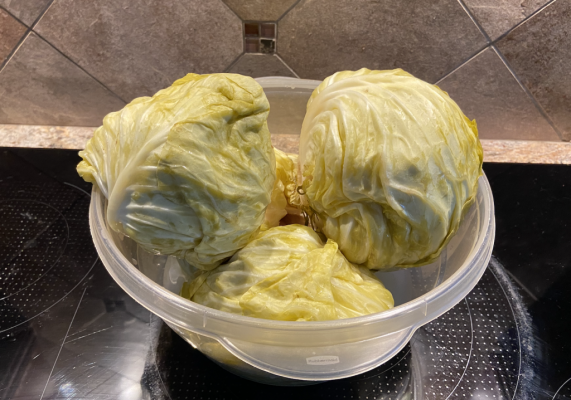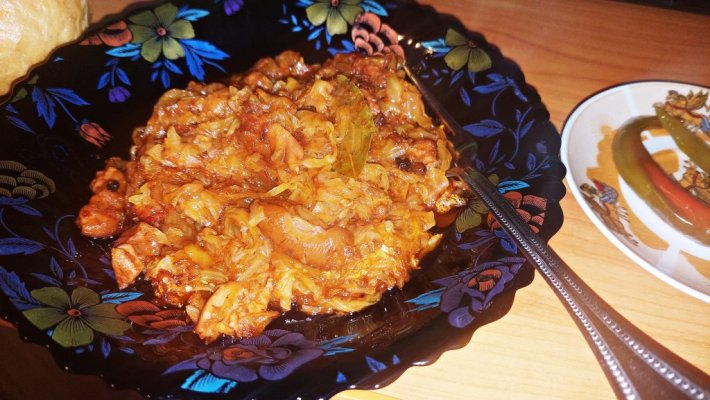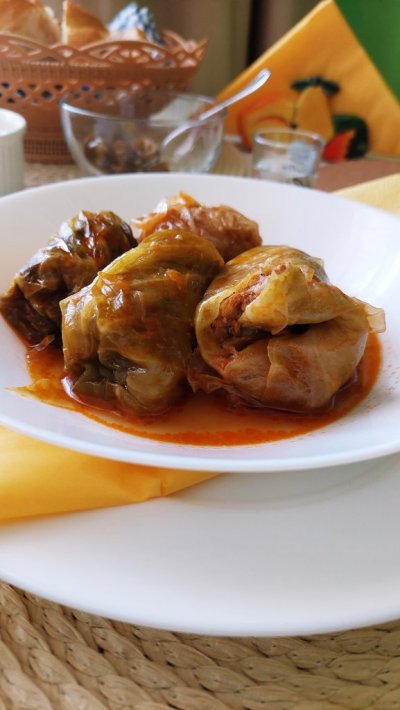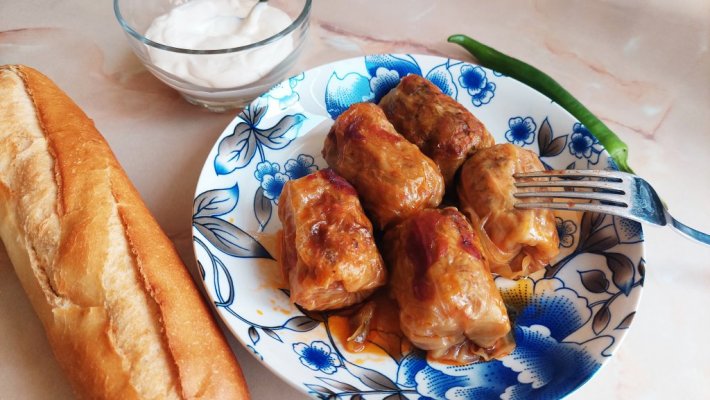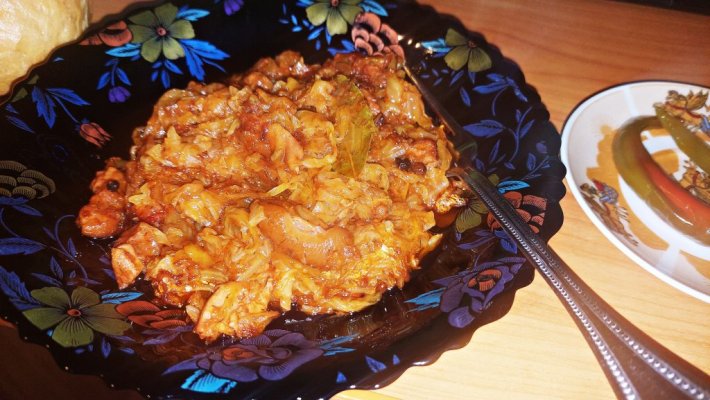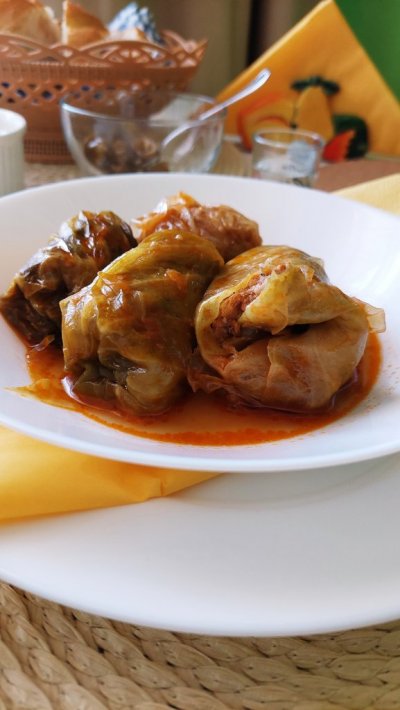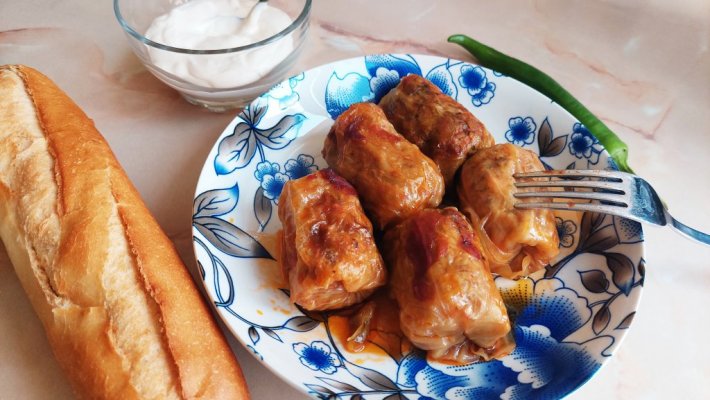hah, I'm quick like that XDI agree with taxy, feel free to post your link.
LOL, you beat me to the punch of posting.
You are using an out of date browser. It may not display this or other websites correctly.
You should upgrade or use an alternative browser.
You should upgrade or use an alternative browser.
Do you like pickled cabbage, not sauerkraut, but in brine with salt, or that's something only Romanians do?
- Thread starter Real Help
- Start date
The friendliest place on the web for anyone that enjoys cooking.
If you have answers, please help by responding to the unanswered posts.
If you have answers, please help by responding to the unanswered posts.
larry_stewart
Master Chef
Love the video, I will definitely try this when I get the chance. Thanks for posting it .
DittoLove the video, I will definitely try this when I get the chance. Thanks for posting it .
Sir_Loin_of_Beef
Chef Extraordinaire
You know what they say, "When in Rome, do like the Romanians."Pickling cabbage the "Romanian way" requires a brine made from water + salt = salted water. It goes 1 tbsp of salt to every 10 liters of water used (2,6 gallons). I never pickled just one cabbage. Whenever I start this pickling process (usually autumn season) I pickle on average about 100-120 kilograms (220-265 pounds) of cabbage. It takes about 6 maybe 7 weeks sometimes for the pickling to be done. Depends very much on the weather since this pickling method relies on temperature, time and salt. You also need to scoop the core of each cabbage and fill it with rock salt before adding into the brine. The airing process consists in literally airing the brine with a hosepipe for a couple of minutes every 3 days. Based on my calculations, if you want to pickle one single cabbage just to try it out, it would be done in a week or so, only if you keep the cabbage in a controlled temperature environment of 25 degrees Celsius. (77 F)
The waiting time changes for each degree under 25 degrees Celsius.
Is not a hard process at all, but it is different from making sauerkraut for sure.
That's why I asked what I asked, I was curious to see if other people use this method or is it something more specific to our country / region.
larry_stewart
Master Chef
Or in my case, when in New York, do like the Romanians, and I can't wait.You know what they say, "When in Rome, do like the Romanians."
larry_stewart
Master Chef
So the simple answer to your question, is this method seems to be more specific to your country / region. I have never done it with a whole intact head of cabbage. For sauerkraut it is shredded thin, the only ingredients are cabbage, salt and sometimes a little water to make sure the cabbage is totally covered. Ive heard people using caraway seeds. I 've also seen recipes where they throw in a green apple. Ive never done either of those. Temperature definitely plays a role in how long it takes to be complete . Sometimes as early as 3 or 4 days. Other times could take a week or two ( hotter environment goes quicker, colder takes longer). The other thing I do is the pickled cabbage. I cut the cabbage into 1 - 2 cm strips, sometimes chunks. Place in a jar with salt, garlic, bayleaf salt and a sometimes a little vinegar ( the vinegar seams to speed up the process and add a slightly different flavor. I dont use a lot. This environment plays the same role in determining the rate of fermentation. The sauerkraut recipe I got online. I think its a basic recipe. I'm not sure where it originated but would assume Eastern Europe. The pickled cabbage I make was basically me, having made pickles most my life( and loving them) , looking for ways to use up extra cabbage. No real recipe, just trial and error til I get it right, using similar methods to when I make regular pickles. I learned to make pickles from my dad, who learned from his dad. My dad's ancestors could be traced back to Poland, Russia, Hungary, Austria .. So I'm not sure if thats where he learned or just picked it up himself ( I never knew my grandfather, as he died before I was born, so I could never ask).Pickling cabbage the "Romanian way" requires a brine made from water + salt = salted water. It goes 1 tbsp of salt to every 10 liters of water used (2,6 gallons). I never pickled just one cabbage. Whenever I start this pickling process (usually autumn season) I pickle on average about 100-120 kilograms (220-265 pounds) of cabbage. It takes about 6 maybe 7 weeks sometimes for the pickling to be done. Depends very much on the weather since this pickling method relies on temperature, time and salt. You also need to scoop the core of each cabbage and fill it with rock salt before adding into the brine. The airing process consists in literally airing the brine with a hosepipe for a couple of minutes every 3 days. Based on my calculations, if you want to pickle one single cabbage just to try it out, it would be done in a week or so, only if you keep the cabbage in a controlled temperature environment of 25 degrees Celsius. (77 F)
The waiting time changes for each degree under 25 degrees Celsius.
Is not a hard process at all, but it is different from making sauerkraut for sure.
That's why I asked what I asked, I was curious to see if other people use this method or is it something more specific to our country / region.
The closest thing I ever had to what you mentioned, was when I was little , we used tot travel into New York City to the lower east side. We would stop by Guss's Pickles. They had so many varieties of pickled Items, one of which being pickled cabbages cut in quarters. Im not sure if they were pickled whole, then cut in quarters to sell that way, or if they were cut in quarters than pickled. Ether way they were great. Another thing they sold was something called a 'Roll mop". or at least that's what I remember it as. I was a very little kid when I had it, so I could be wrong with the name. It was basically a large cabbage leaf stuffed with a bunch of other pickled items ( sauerkraut, pickled cucumbers ...) and all rolled up ( like a burrito). Im not sure if that outer leaf came from a whole pickled cabbage, or whatever, Either way, it was great >
We take pickling very seriously around this neck of the woods and we have a huge variety of pickles. It's a part of our way of living. We pickle everything and I mean everything. Green tomatoes, carrots, spicy peppers, watermelon, cauliflower, cucumbers, and sweet peppers. Basically, every type of vegetable besides potatoes can and will be pickled. There are dozens of recipes, there are peppers stuffed with cabbage, or a "multibarrel", that includes a mixture of green tomatoes with carrots, cauliflower, etc. This is a huge, huge topic. Cabbage is the tip of the iceberg.So the simple answer to your question, is this method seems to be more specific to your country / region. I have never done it with a whole intact head of cabbage. For sauerkraut it is shredded thin, the only ingredients are cabbage, salt and sometimes a little water to make sure the cabbage is totally covered. Ive heard people using caraway seeds. I 've also seen recipes where they throw in a green apple. Ive never done either of those. Temperature definitely plays a role in how long it takes to be complete . Sometimes as early as 3 or 4 days. Other times could take a week or two ( hotter environment goes quicker, colder takes longer). The other thing I do is the pickled cabbage. I cut the cabbage into 1 - 2 cm strips, sometimes chunks. Place in a jar with salt, garlic, bayleaf salt and a sometimes a little vinegar ( the vinegar seams to speed up the process and add a slightly different flavor. I dont use a lot. This environment plays the same role in determining the rate of fermentation. The sauerkraut recipe I got online. I think its a basic recipe. I'm not sure where it originated but would assume Eastern Europe. The pickled cabbage I make was basically me, having made pickles most my life( and loving them) , looking for ways to use up extra cabbage. No real recipe, just trial and error til I get it right, using similar methods to when I make regular pickles. I learned to make pickles from my dad, who learned from his dad. My dad's ancestors could be traced back to Poland, Russia, Hungary, Austria .. So I'm not sure if thats where he learned or just picked it up himself ( I never knew my grandfather, as he died before I was born, so I could never ask).
The closest thing I ever had to what you mentioned, was when I was little , we used tot travel into New York City to the lower east side. We would stop by Guss's Pickles. They had so many varieties of pickled Items, one of which being pickled cabbages cut in quarters. Im not sure if they were pickled whole, then cut in quarters to sell that way, or if they were cut in quarters than pickled. Ether way they were great. Another thing they sold was something called a 'Roll mop". or at least that's what I remember it as. I was a very little kid when I had it, so I could be wrong with the name. It was basically a large cabbage leaf stuffed with a bunch of other pickled items ( sauerkraut, pickled cucumbers ...) and all rolled up ( like a burrito). Im not sure if that outer leaf came from a whole pickled cabbage, or whatever, Either way, it was great >
We also have the vinegar type of pickling. But that type is used when you want something crunchy. Vinegar while accelerating the pickling process will also add that stingy sensation.
Back in my grandma's days pickling here meant only this type with salt, while the one with vinegar was called marinating, like in marinated cucumbers and not pickled cucumbers for cucumbers with vinegar, and pickled cucumbers only for the salted ones, pickling meaning = to ferment. And fermenting takes place when souring with salt.
I, my whole family actually, pickled in every way possible over the years, adding all sorts of condiments to enrich the flavor and test to discover something even better. But we realized, more I realized, ( I was being told already that this way is better but I had to be the smart one that will reinvent the wheel) that when you add more stuff to your brine, no matter what you are pickling, the taste will be chaotic with all types of flavors that in reality don't complement each other, from apples to cumin, everything was tested, and the line was drawn. Simpler is better.
The way you prepare is excellent, but it's a different recipe. Now pickles here mean both things since they are served for the same purpose almost. The only difference is that from pickles made with salt you can prepare other dishes as well (pickled cabbage with bacon for ex) while the ones made with vinegar their sole purpose is a side garnish or salad.
I really hope you try it when you get the chance because I think you might love it.
Last edited:
larry_stewart
Master Chef
I definitely think I'll love it.I really hope you try it when you get the chance because I think you might love it.
I agree with the simpler is better philosophy.
When making pickled cucumbers , I rarely add more than 2 or three spices. I may make different varieties with different spice blends, but I dont overload it with too many flavors.
Spices are normally would use are Mustard seed, coriander seed, celery seed, pepper corns, bay leaf and I have even seen cinnamon, but I dont use it. I wouldn't use all of these at once maybe I'd pair 2 together.
Fresh herbs or vegetables I would use are Garlic, Pepper, horse radish , ginger, dill, hot dried chili pepper. Again, I wouldn't use all at once, maybe 1 or 2 depending on the flavor I want.
Sometimes Im in the mood for a very simple pickle, and will just use garlic, water ,salt and cucumbers and thats it.
I also love pickles at all stages of the pickling process, so I'm always tasting them each day. Rarely do they ever get to the point of being really sour, cause I eat them too quickly.
I grow my own cucumbers for pickling, and often ( especially by the end of the growing season) will have so many, that I experiment with everything.
I usually only use vinegar when making a cucumber salad ( Water, cucumbers, dill, onions, salt, vinegar and a little sugar). Occasionally, I'll make a more vinegary pickle. I like the vinegar ones aon sandwiches and burgers. I like the fermented pickles, without vinegar, just for eating and snacking on.
Sorry for rambling on and on, its 4:30 am and I cant sleep , so what better way to spend my awake time than with talking about pickles.
larry_stewart
Master Chef
So I did it!
Actually started a few weeks ago.
I got a few smaller cabbages that filled up a 3 gallon container ( didnt want to go any bigger as I dont need that much pickled cabbage). The room I kept it in was on the warmer side, so the pickling process was Spd up significantly.
Didnt run into any problems.
Definitely doesnt taste like sauerkraut. It has a more of pickled flavor. The leaves are more pliable ( but still have crunch to them). Sauerkraut ( to at least mine) is a bit more crunchy. Glad I tried doing it. They are in the fridge now, waiting for me to figure out what to do with them ( other than snacking on them). Thanks for introducing me to this process. I love learning and trying new things.
Actually started a few weeks ago.
I got a few smaller cabbages that filled up a 3 gallon container ( didnt want to go any bigger as I dont need that much pickled cabbage). The room I kept it in was on the warmer side, so the pickling process was Spd up significantly.
Didnt run into any problems.
Definitely doesnt taste like sauerkraut. It has a more of pickled flavor. The leaves are more pliable ( but still have crunch to them). Sauerkraut ( to at least mine) is a bit more crunchy. Glad I tried doing it. They are in the fridge now, waiting for me to figure out what to do with them ( other than snacking on them). Thanks for introducing me to this process. I love learning and trying new things.
Attachments
I'm really interested in hearing about the ways you find to use this.
larry_stewart
Master Chef
Me too lolI'm really interested in hearing about the ways you find to use this.
Up til now, I was focussing more on just pickling them successfully. I should have prepared myself for what I waned to do with them once they are done.
The one thing I must say, is that Im glad my wife wasn't home when I took them out of the crock. Took a few hours for the pickled cabbage smell to subside. Last time I ran into a situation like that was when I ordered a Durian fruit.
OMG! You really did it!So I did it!
Actually started a few weeks ago.
I got a few smaller cabbages that filled up a 3 gallon container ( didnt want to go any bigger as I dont need that much pickled cabbage). The room I kept it in was on the warmer side, so the pickling process was Spd up significantly.
Didnt run into any problems.
Definitely doesnt taste like sauerkraut. It has a more of pickled flavor. The leaves are more pliable ( but still have crunch to them). Sauerkraut ( to at least mine) is a bit more crunchy. Glad I tried doing it. They are in the fridge now, waiting for me to figure out what to do with them ( other than snacking on them). Thanks for introducing me to this process. I love learning and trying new things.
And they look perfect!So I did it!
Actually started a few weeks ago.
I got a few smaller cabbages that filled up a 3 gallon container ( didnt want to go any bigger as I dont need that much pickled cabbage). The room I kept it in was on the warmer side, so the pickling process was Spd up significantly.
Didnt run into any problems.
Definitely doesnt taste like sauerkraut. It has a more of pickled flavor. The leaves are more pliable ( but still have crunch to them). Sauerkraut ( to at least mine) is a bit more crunchy. Glad I tried doing it. They are in the fridge now, waiting for me to figure out what to do with them ( other than snacking on them). Thanks for introducing me to this process. I love learning and trying new things.
Well, I don't even know where to reply. I am going to do it in both comments. I am so hyped, it's like I won the big prize. You guys were not only interested about the process, but actually did it. And I helped. I know, I behave like 10 yo and I can be annoying for some people, but I can't help it.I'm really interested in hearing about the ways you find to use this.
Alright so, this cabbage is the main ingredient for minced meat cabbage rolls. I don't know if you guys heard of them. It's a traditional recipe here in Romania. I will attach some photos maybe you can recognize them. They are called "sarmale". And you can't make sarmale without cabbage that's pickled this way. I mean you can, of course, every recipe is a source of inspiration, but the real "sarmale" the traditional ones we always make are made from pickled cabbage. The cabbage and the meat are the main ingredient for the taste. That's why the cabbage needs to be soured with salt.
There is another course which would be called " Braised pickled cabbage with bacon and sausages" which is made in the oven. And like any other recipe has dozens of variations.
Another one would be "Braised pickled cabbage a la Cluj" which is pretty much cabbage in the oven again, but with minced meat layered like in a lasagna.
And there is also a side salad you can make from this cabbage. You just cut the cabbage (shred it, like in sauerkraut) add a pinch of sunflower oil, or olive oil, I like the sunflower one better for this salad, and some pepper, and voila. The side salad is done. It goes perfectly with just about everything.
I don't know about other countries or regions, but here in Romania, side salad is as important as bread.
You can't eat a steak without a side salad and a nice pita bread or fresh bread in general. You can't do that to the steak, or to you. It's like an insult.
Me too lol
Up til now, I was focussing more on just pickling them successfully. I should have prepared myself for what I waned to do with them once they are done.
The one thing I must say, is that Im glad my wife wasn't home when I took them out of the crock. Took a few hours for the pickled cabbage smell to subside. Last time I ran into a situation like that was when I ordered a Durian fruit.
Attachments
Well, I don't even know where to reply. I am going to do it in both comments. I am so hyped, it's like I won the big prize. You guys were not only interested about the process, but actually did it. And I helped. I know, I behave like 10 yo and I can be annoying for some people, but I can't help it.I'm really interested in hearing about the ways you find to use this.
1. Alright so, this cabbage is the main ingredient for minced meat cabbage rolls. I don't know if you guys heard of them. It's a traditional recipe here in Romania. I will attach some photos maybe you can recognize them. They are called "sarmale". And you can't make sarmale without cabbage that's pickled this way. I mean you can, of course, every recipe is a source of inspiration, but the real "sarmale" the traditional ones we always make are made from pickled cabbage. The cabbage and the meat are the main ingredient for the taste. That's why the cabbage needs to be soured with salt.
2. There is another course which would be called " Braised pickled cabbage with bacon and sausages" which is made in the oven. And like any other recipe has dozens of variations.
3. Another one would be "Braised pickled cabbage a la Cluj" which is pretty much cabbage in the oven again, but with minced meat layered like in a lasagna.
4. And there is also a side salad you can make from this cabbage. You just cut the cabbage (shred it, like in sauerkraut) add a pinch of sunflower oil, or olive oil, I like the sunflower one better for this salad, and some pepper, and voila. The side salad is done. It goes perfectly with just about everything.
I don't know about other countries or regions, but here in Romania, side salad is as important as bread.
You can't eat a steak without a side salad and a nice pita bread or fresh bread in general. You can't do that to the steak, or to you. It's like an insult.
Attachments
I totally forgot to warn you about the smell, it really ... surprises you... I'm sorry.Me too lol
Up til now, I was focussing more on just pickling them successfully. I should have prepared myself for what I waned to do with them once they are done.
The one thing I must say, is that Im glad my wife wasn't home when I took them out of the crock. Took a few hours for the pickled cabbage smell to subside. Last time I ran into a situation like that was when I ordered a Durian fruit.
blissful
Master Chef
- Joined
- Mar 25, 2008
- Messages
- 6,358
Now I want to go to Larry's for dinner! My mouth is watering.
@Real Help "You guys were not only interested about the process, but actually did it. And I helped. I know, I behave like 10 yo and I can be annoying for some people, but I can't help it."
Genuine excitement is not annoying, not at all. I especially like this about you.
@Real Help "You guys were not only interested about the process, but actually did it. And I helped. I know, I behave like 10 yo and I can be annoying for some people, but I can't help it."
Genuine excitement is not annoying, not at all. I especially like this about you.
larry_stewart
Master Chef
It's situations like this why I like this forum so much. I love learning new recipes, techniques, ingredients ... to broaden my culinary experiences. Especially learning things from different cultures and countries. To me, this experience was like gold. I learned something new, and I was able to duplicate its in my own kitchens with my own hands. The only thing that would make it better, is if I was able to travel to different countries to experience these things first hand. Since I'm not a big fan of flying, and its impossible to drive across the ocean, I'll have to rely on people I meet here. I really have learned so much from this group.Well, I don't even know where to reply. I am going to do it in both comments. I am so hyped, it's like I won the big prize. You guys were not only interested about the process, but actually did it. And I helped. I know, I behave like 10 yo and I can be annoying for some people, but I can't help it.
I kinda knew it was going to let off a cabbagy smell. I kept it out in my plant room which stays at a consistent temperature. sAw long as the crock was covered , there was no issue. Anytime I opened it to check, or to blow the bubble , thats when the smell kicked in. I purposely took them out at a time and day I knew my wife wouldn't be around. The smell lasted longer than expected , but did go away before she got home.I totally forgot to warn you about the smell, it really ... surprises you... I'm sorry.
Thanks again for teaching this method to me. Once I figure out what Im going to do with them, Ill post back.
I will try to explain the golden recipe of Romanian cuisine in writing. If you have time to experiment with it or you are curious about it. This pickled cabbage is mainly made for sarmale. It's time-consuming. It's really time-consuming, especially for someone who never made it or heard of it. It's time-consuming for me whenever I make sarmale and I made them hundreds of times, if not thousands. I cook since I was 13 yo so I am really not exaggerating or trying to impress.It's situations like this why I like this forum so much. I love learning new recipes, techniques, ingredients ... to broaden my culinary experiences. Especially learning things from different cultures and countries. To me, this experience was like gold. I learned something new, and I was able to duplicate its in my own kitchens with my own hands. The only thing that would make it better, is if I was able to travel to different countries to experience these things first hand. Since I'm not a big fan of flying, and its impossible to drive across the ocean, I'll have to rely on people I meet here. I really have learned so much from this group.
I kinda knew it was going to let off a cabbagy smell. I kept it out in my plant room which stays at a consistent temperature. sAw long as the crock was covered , there was no issue. Anytime I opened it to check, or to blow the bubble , thats when the smell kicked in. I purposely took them out at a time and day I knew my wife wouldn't be around. The smell lasted longer than expected , but did go away before she got home.
Thanks again for teaching this method to me. Once I figure out what Im going to do with them, Ill post back.
Ingredients:
- 1 kg and a half or 3,3 pounds of minced pork meat. Next to the perfect cabbage is the perfect meat. You don’t go willingly making sarmale from the upper leg part of the pork that contains a large amount of muscle. The sarmale will be very dense, hard, and not juicy at all. The best kind of meat to use for sarmale is a portion that is very rich in fat. Usually, it’s the belly region. But even then, you still need to bring some more fat into the mix. The perfect proportions for soft and tasty sarmale is 65 % meat and 35 % fat, pure fat. The white kind of fat. Based on the percentage I provided it would result in 1 kilogram of meat and 500 grams of fat. (2,2 pounds meat + 1,1 pounds fat).
- 2-3 pieces of pickled cabbage. Depending on the size of your cabbage might be 3 if they are small, or just 1 if it’s a huge one.
- 3 onions.
- 2 tablespoons of tomato paste.
- 250 ml or 6,7 fluid ounces of tomato juice.
- Bay leaves.
- Peppercorns.
- 150 grams or 5,3 ounces of rice. Presoak the rice for 1 h before cooking.
- 100 grams or 3,5 ounces of bacon. Now my bacon is different from yours. When I refer to bacon I mean something similar to pancetta. But regular bacon is also good to use.
- ideally 2 tbsp lard or 50 ml or 1,7 fluid ounces of sunflower oil
- 1 liter or 34 fluid ounces of water.
- A condiment mix that contains:
- 2 teaspoons of thyme.
- 1 teaspoon of salt.
- 1 teaspoon of dried dill.
- 1 teaspoon of sweet smoked paprika. regular sweet paprika also works.
- 1 teaspoon of pepper.
- Optional half a teaspoon of garlic powder.
Take the bacon and cut it into cubes. Add the bacon to a hot pan with all 50 ml of sunflower oil and the lard. But if you don't have lard at all its ok to use only oil. Cook it for 5 minutes on the smallest setting of your stove. You want the flavor of the bacon to mix with the oil.
After 5 minutes, remove the bacon and add the finely chopped onions. You need to cook the onions for a few minutes then add the pre-soaked rice and again let it cook for another 5 minutes.
After you add the rice make sure you constantly stir so the rice won't stick to the pan. When the onions and rice have cooked for a total of 10 minutes now, add 1 tablespoon of tomato paste and the minced canned tomatoes. Let the whole thing cook for another 10 minutes on the lowest power but constantly mix to make sure nothing gets burned or stuck on the bottom of the pan.
Once the sauce is made, let it cool off while you start working at the cabbage.
Unwrap the cabbage with care so the leaves won't break. Remove the big vein, it’s hard and it will be hard to fold as well. It also boils harder.
Depending on its size you can make 2 or even 3 pieces of leaves for you to wrap the meat rolls. Some housewives make very small meat rolls which obviously will require a smaller piece of leaf. I make them somewhere in between and from one cabbage leaf I'm getting 2 individual pieces of wrapping. If the cabbage has thick layers it will be a lot harder to wrap each sarma.
When you are getting to the end portion where the leaves are pretty small and you can’t make even one single wrapping from a piece of leaf, finely cut the cabbage. You will use this as a bottom layer so the sarmale won't face the bottom of the pot directly.
After you finish preparing the leaves, start preparing the meat.
Add the sauce on top of the meat and the condiment mix and start blending and kneading. You will treat the meat as if you are kneading dough. You need to incorporate everything evenly and spread the condiments equally.
Before starting the actual folding of the sarma, prepare the cabbage layer. In a pot or a tray that also is good for oven usage and add pieces of cut pickled cabbage as a bed for the incoming sarmale. Add bay leaves and peppercorns and you can also add the bacon pieces you fried at the beginning of the recipe.
Now comes the fun part, the wrapping of each sarma. You wrap the meat in cabbage leaves. Is not hard and everyone will find what works best for them while they're wrapping, you will find the flow, and how it's the easiest. Place the cabbage leaf in your hand, take the meat with the other hand and place it on top of the leaf. The amount of meat should be smaller of course than the size of the wrapping leaf. Around 2 teaspoons, maybe 3. Roll it then shove the corners of the leaf inside of the roll and voila, your sarma is done. Place each sarma in the tray as you shape them. The cooking will take place in 2 stages, one the boiling stage, and second the roasting stage.
If you find yourself too tired to make, shape, and cook the sarmale on the same day, after you shaped them, you can place them in the refrigerator overnight without any issues. It’s actually tastier if you let the sarmale rest for 10 - 12 hours before cooking. This way all the condiments will enrich the meat and the cabbage, and it will have a more defined and rich taste.
Add 1 tablespoon of tomato paste in 1 liter of water and mix. Pour the water mixture over the sarmale and put them to boil for 3 hours on the lowest setting of your stove. Every hour add 1 cup or less of water to compensate for the water that evaporates during boiling. That would be a total of 3 cups more or less than the 4 initial ones.
After 3 hours of boiling, switch to roasting. Add a lid over the tray, or aluminum foil and put the sarmale in the oven for 1 hour and a half on low power. They need to slow roast with the lid on the entire time.
After 1 hour and a half remove the lid, and let them roast for another 40-50 minutes, again at the smallest setting of your oven.
It feels like I wrote a novel... I hope I am not boring you with these details you never requested
LOL, you did write a novel - but a fascinating one! Recipes that are new to someone have a much better chance of success with as many details as possible!
So would your pan be about 2 or 3 layers deep? And in the end, there would be lots of sauce but not swimming or drowning in liquid.
I honestly admit I doubt I will make them - but never say never! I am still copying/saving the recipe. So maybe one day...
So would your pan be about 2 or 3 layers deep? And in the end, there would be lots of sauce but not swimming or drowning in liquid.
I honestly admit I doubt I will make them - but never say never! I am still copying/saving the recipe. So maybe one day...
Similar threads
- Replies
- 0
- Views
- 213
- Replies
- 50
- Views
- 3K

